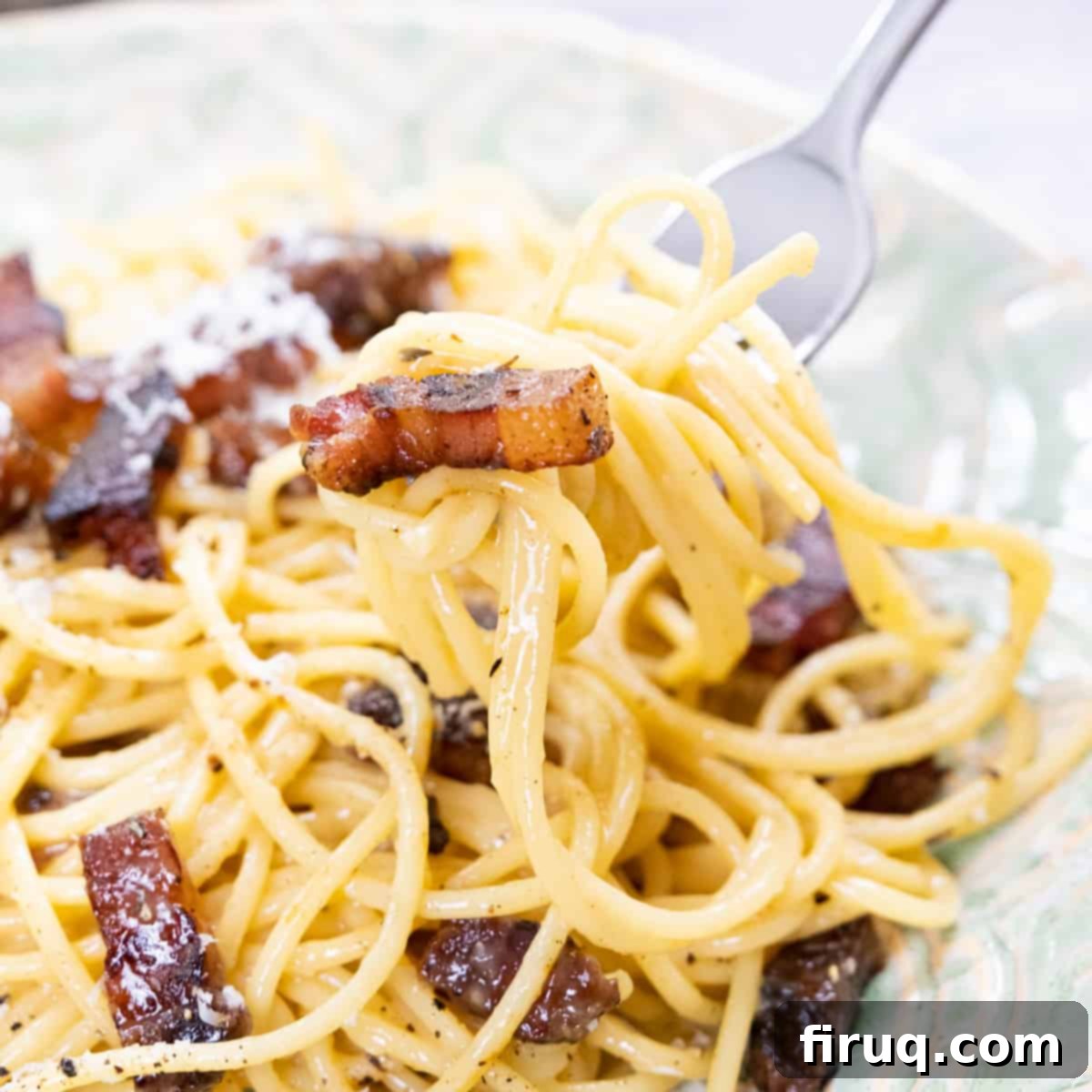Mastering Authentic Spaghetti Carbonara: Your Ultimate Guide to a Silky, Creamy Roman Classic
Spaghetti Carbonara is more than just a pasta dish; it’s a cherished Roman culinary masterpiece, renowned for its incredibly rich, silky-smooth sauce. This iconic recipe commands respect, and purists often become quite passionate when deviations occur. To help you navigate the traditions and successfully create the most authentic version of this beloved dish, we’ve compiled an essential guide covering all the crucial Spaghetti Carbonara do’s and don’ts. Prepare to impress even the most discerning Italian food enthusiasts!
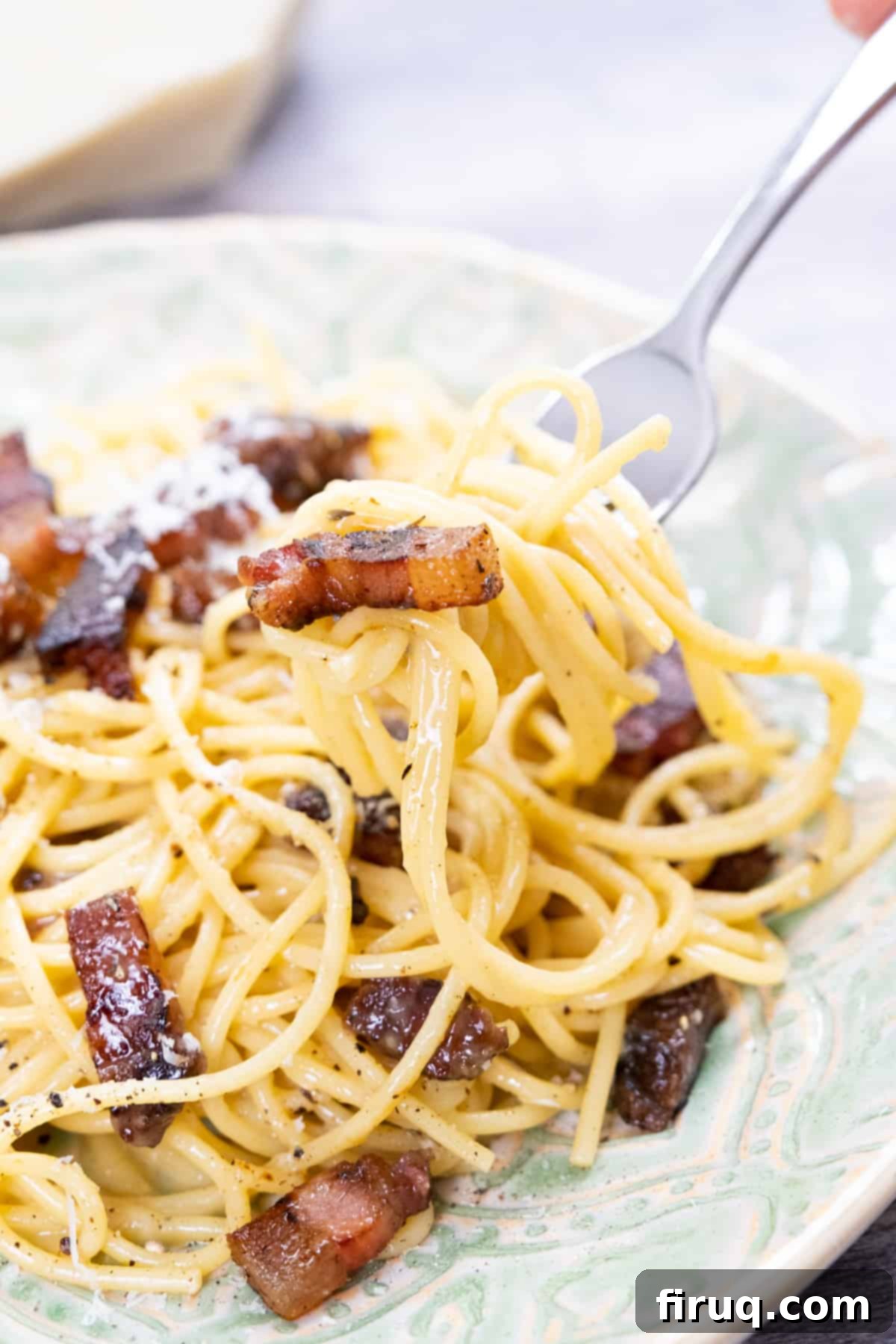
Craving more classic pasta dishes? Be sure to explore our recipes for Pasta with Peas and Pancetta or Artichoke Pesto Pasta!
The Carbonara Challenge: Navigating Tradition and Achieving Perfection
You might have heard tales of the legendary Spaghetti Carbonara police. Rest assured, they operate internationally, ready to “inform” you of any culinary transgressions when preparing this iconic dish! My goal with this comprehensive guide, structured around key Spaghetti Carbonara do’s and don’ts, is to empower you to create a dish you’ll be genuinely proud of, without fear of judgment.
It’s important to acknowledge that many people, myself included, don’t get this dish right on their first attempt. Carbonara isn’t necessarily a “hard” recipe in terms of complex steps, but it demands a specific technique and a keen understanding of temperature control. My own journey began years ago with a rather unconventional choice: bacon. Yes, bacon. While delicious in its own right, it’s a far cry from the traditional guanciale. Thankfully, I’ve come a long way since then!
Through countless trials and extensive testing, I’ve refined this recipe, aiming to provide you with invaluable tips and tricks to master this Roman classic. Dishes like Carbonara, Bucatini Amatriciana, Pasta alla Gricia, or Pasta alla Norma are deeply rooted in specific traditions and ingredients. Achieving their authentic flavor and texture takes patience and precision. This detailed guide to Carbonara is designed to shorten your learning curve and help you achieve perfection faster!
Key Ingredients for Authentic Spaghetti Carbonara: Selection and Substitutions
The beauty of authentic Carbonara lies in its simplicity, relying on just a few high-quality ingredients to create a symphony of flavors. Understanding each component is crucial for success.
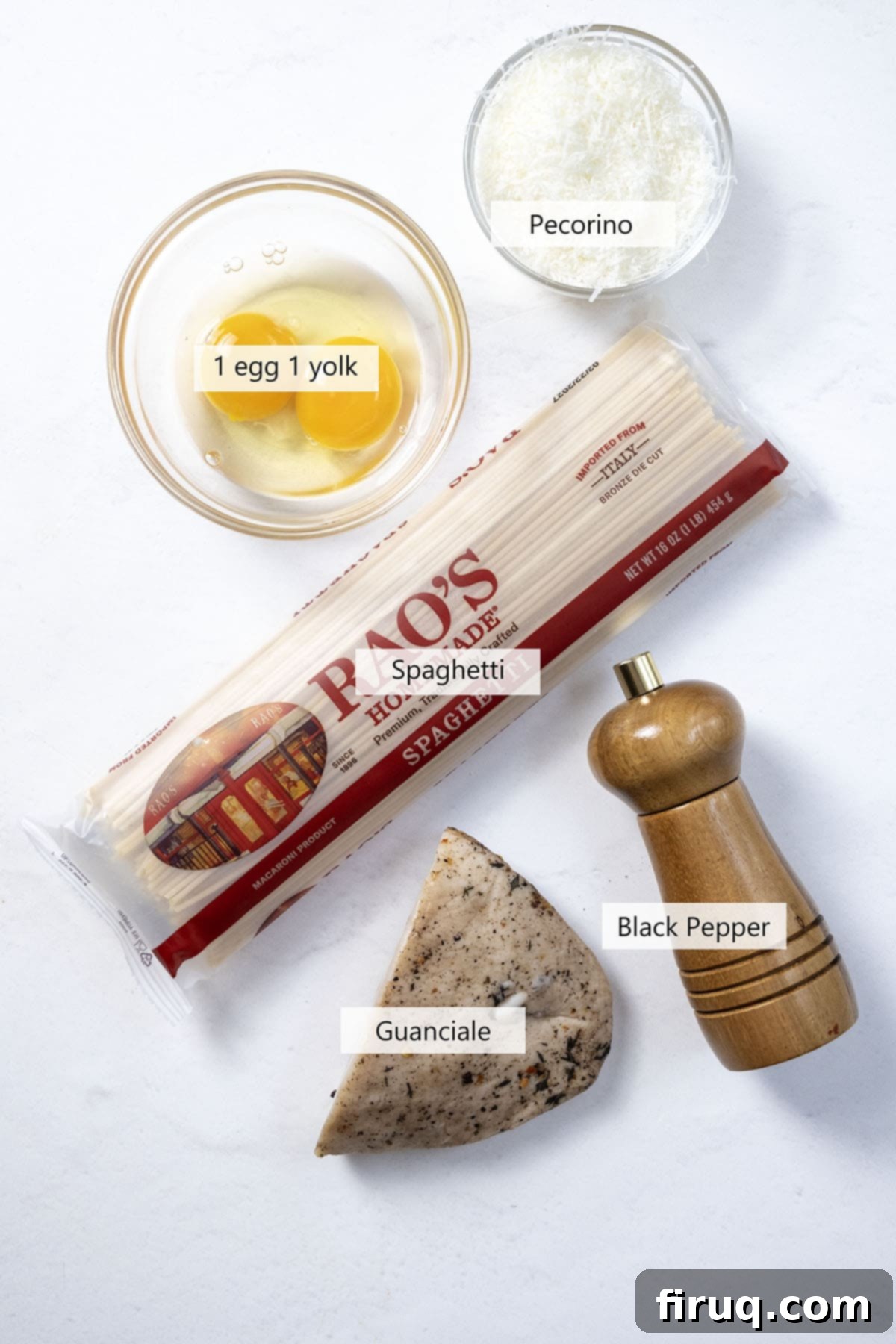
-
Guanciale or Pancetta: The Heart of Carbonara’s Flavor
Guanciale is the traditionally preferred ingredient. This cured pork jowl boasts an incredibly rich, complex, and slightly sweet flavor profile, and its fat renders beautifully to create the base of the sauce. If guanciale isn’t readily available, high-quality pancetta (cured pork belly) is an excellent and widely accepted substitute. While pancetta offers a slightly different, often saltier and chewier texture, it still provides the essential fatty richness needed for a superb Carbonara. Avoid using smoked bacon, as its strong smoky flavor will overpower the delicate balance of the authentic dish.
-
The Role of Freshly Ground Black Pepper (Pepe Nero)
Often overlooked, black pepper is a crucial component that adds a distinctive aroma and a subtle, peppery kick. Always use freshly ground black pepper, preferably coarse, to maximize its flavor and texture. It’s not just a garnish; it’s an integral flavor enhancer for the sauce.
-
Choosing the Right Pasta: Dried Spaghetti for Superior Texture
For dishes like Carbonara or Pasta alla Gricia, it’s generally best to use dried pasta, particularly bronze-die cut varieties like spaghetti or bucatini. The rougher surface of dried pasta holds the sauce better, and, more importantly, it releases more starch into the cooking water. This starchy water is vital for emulsifying the sauce, creating that desirable creamy and silky-smooth consistency that fresh pasta simply cannot achieve as effectively.
-
Eggs for Emulsification: Whole Eggs, Yolks, or a Combination?
The great egg debate in Carbonara! Some purists insist on using only egg yolks, while others prefer whole eggs. I find a combination of whole eggs and additional egg yolks yields the perfect balance of richness and creaminess. The egg whites, when combined with the starchy pasta water and managed carefully, help thicken the sauce beautifully. The key is precise temperature control, as egg whites cook faster than yolks and can lead to a “scrambled egg” texture if the pan is too hot.
-
Pecorino Romano: The Unmistakable Salty Kick
A non-negotiable ingredient! Pecorino Romano, a hard, salty cheese made from sheep’s milk, provides the essential sharp, tangy, and savory flavor that defines Carbonara. While Parmigiano-Reggiano can sometimes be added in small amounts for complexity, Pecorino Romano should always be the primary cheese. Ensure it’s freshly grated and as fine as possible to prevent clumping in the sauce.
-
The Great Garlic Debate: To Add or Not to Add?
For authentic Carbonara, garlic is generally omitted. It’s not traditional, and its strong flavor can easily overpower the delicate nuances of the guanciale, Pecorino, and pepper. While it’s your kitchen and you’re free to experiment, if authenticity is your goal, skip the garlic. As the “Carbonara police” would remind you, sometimes less is more!
*Please see the recipe card below for more detailed information on ingredients and precise measurements.
Step-by-Step Guide: Crafting Your Perfect Spaghetti Carbonara
Creating perfect Carbonara isn’t inherently difficult, but it does require some practice and a keen eye for consistency. The difference between a sublime, creamy sauce and a clumpy, egg-scrambled disaster often comes down to small errors in technique and temperature. Follow these essential do’s and don’ts carefully, and you’ll be on your way to a truly authentic Roman dish. The image below showcases a Carbonara made with pancetta, a fantastic alternative to guanciale!
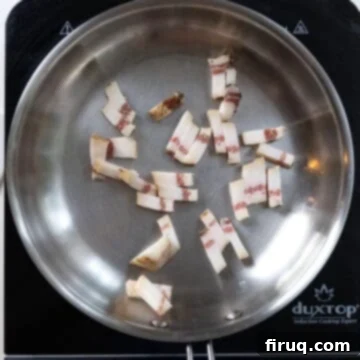
Step 1: Start Cold for Perfect Render. Begin by placing your diced pancetta or guanciale into a cold pan. This crucial step allows the fat to render slowly and evenly as the pan heats up. Raise the heat to medium and cook for approximately 8-10 minutes, or until the pork becomes beautifully golden brown and crispy. Slow rendering extracts maximum flavor and creates rich, savory fat.
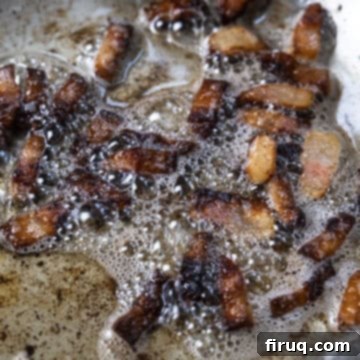
Step 2: Pasta & Fat Preparation. While the guanciale slowly renders and crisps, boil your spaghetti in generously salted water until al dente. Keep an eye on the guanciale, moving it often to ensure even cooking. Once golden and crisp, remove the guanciale with a slotted spoon, leaving the rendered fat (fond) in the pan. This flavorful fat is crucial for the sauce.
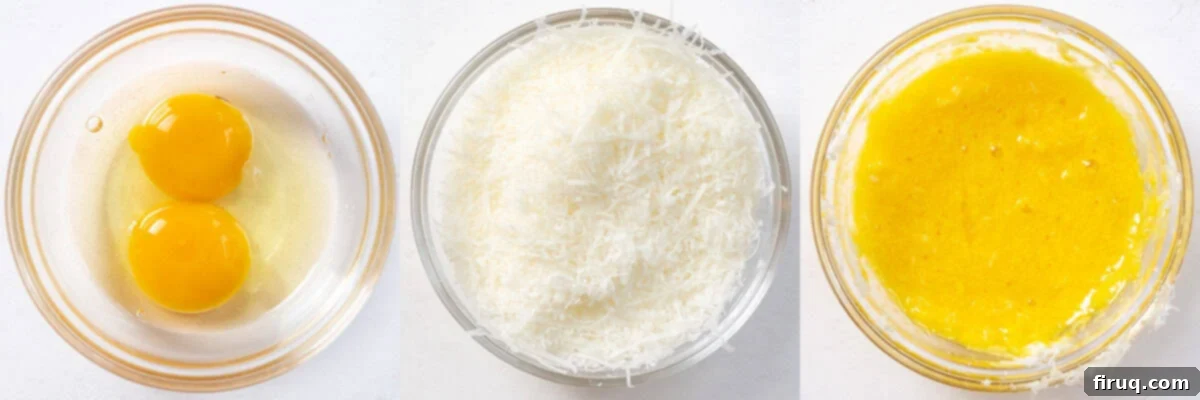
Step 3: Crafting the Creamy Egg & Cheese Base. While the guanciale fries, prepare your egg and cheese mixture. I advocate for a combination of whole eggs and extra egg yolks (e.g., 2 whole eggs and 2 extra yolks for 1 lb pasta) to achieve perfect creaminess without being too heavy. Vigorously whisk the eggs with finely grated Pecorino Romano cheese until thoroughly combined. The argument against using egg whites is that they cook quicker than egg yolks, which is true. However, with careful temperature control, the egg whites contribute to a thicker, more emulsified sauce. Ensure your Pecorino is grated as finely as possible; thicker shreds are more prone to coagulating and creating a chunky, undesirable sauce.
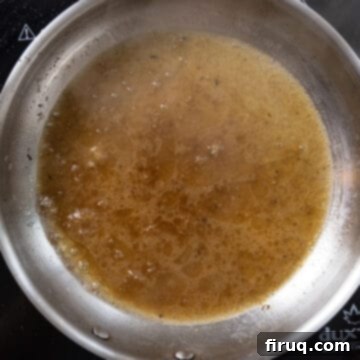
Step 4: Creating the Emulsified Base. Before draining your pasta, reserve at least ½ a cup of the starchy pasta water. Add ¼ cup of this reserved water to the rendered guanciale oil in your saucepan. Stir vigorously to combine, creating a luscious, emulsified base for your sauce. This starchy liquid will bind with the fat, helping to thicken the final sauce.
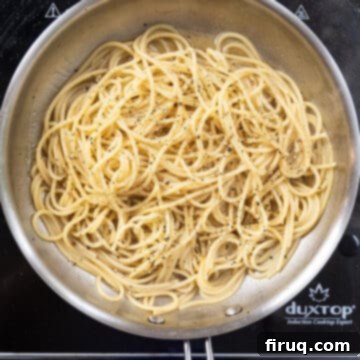
Step 5: Incorporating Pasta & Pepper. Drain your al dente pasta, remembering to save an additional ½ cup of pasta water. Immediately transfer the hot pasta to the saucepan containing the emulsified fat and water. While still on the burner (but with the heat turned OFF or to very low residual heat), generously sprinkle with freshly ground black pepper and stir thoroughly to coat the spaghetti evenly with the flavorful fat.
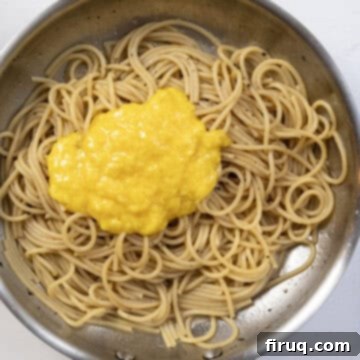
Step 6: The Creamy Transformation – Heat Control is Key! This is the most crucial step. Remove the pan completely from the heat for a minute or two to allow it to cool slightly. This prevents the eggs from scrambling. Then, immediately add your whisked egg and Pecorino mixture along with ¼ cup of the reserved pasta water to the pasta. Stir vigorously and continuously! The sauce will initially appear liquidy, but with constant stirring, the heat from the pasta and the pan’s residual warmth will gently cook the eggs and melt the cheese, forming a beautifully creamy, emulsified sauce. If it’s too thick, add more pasta water, a tablespoon at a time, while continuing to stir.
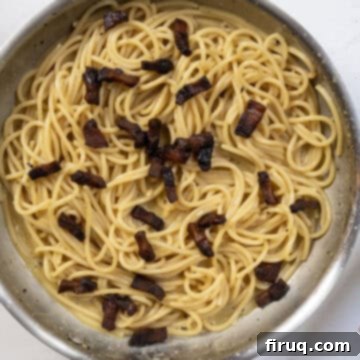
Step 7: Final Assembly and Serving. Once your sauce has reached its desired silky consistency, return the crispy guanciale to the pan and combine well. Add a final sprinkle of fresh black pepper if you wish. It is imperative to remove the pasta from the pan immediately and serve onto warm plates to prevent the residual heat from overcooking the eggs. You want a velvety sauce, not scrambled eggs and pasta!
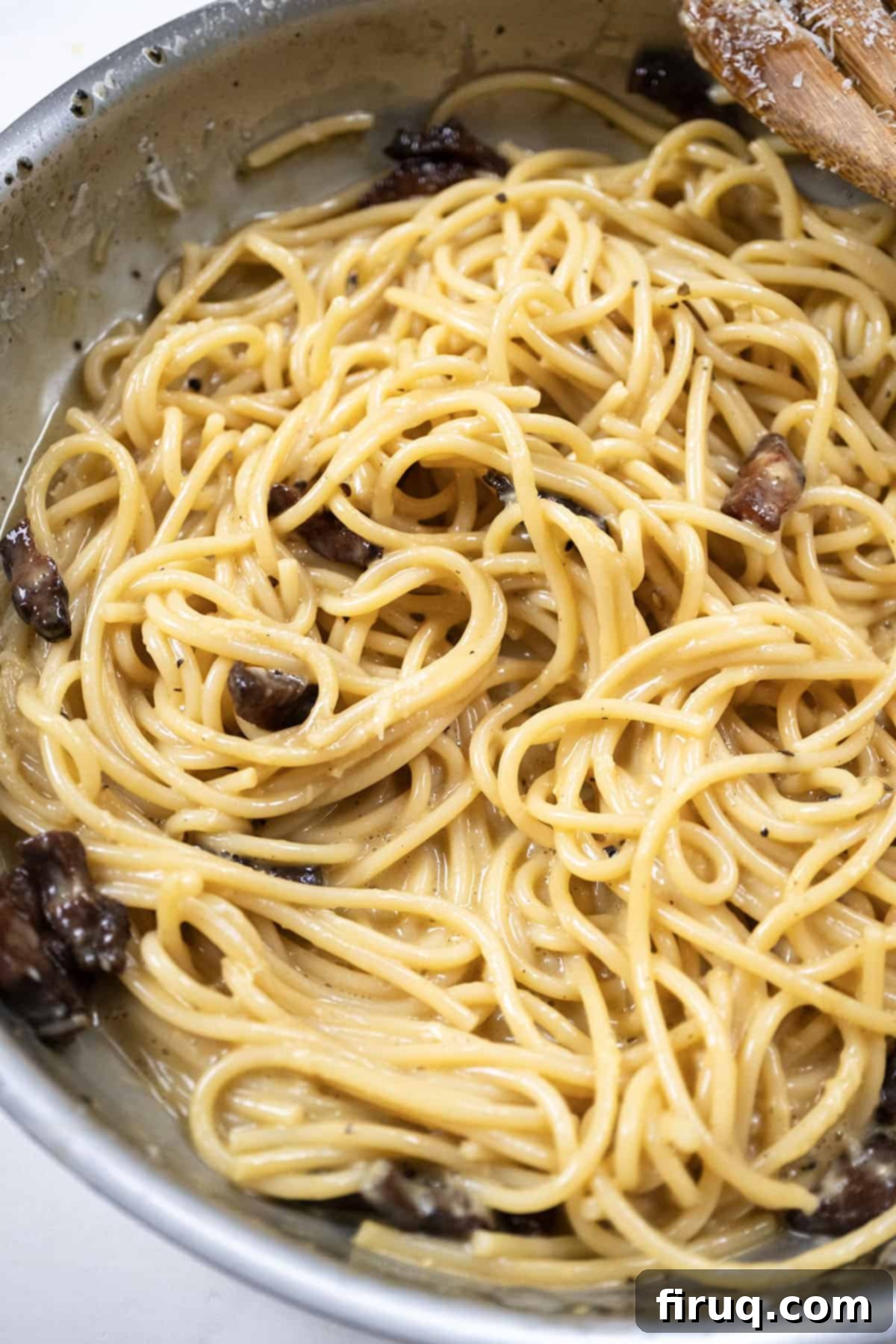
The picture above perfectly illustrates the crucial phase where the Carbonara sauce transitions from a slightly liquidy state to its classic, creamy texture. The key is continuous stirring. The gentle motion and residual heat from the pasta facilitate the emulsion, causing the moisture to slowly dissipate and the sauce to thicken beautifully around each strand of spaghetti.
For a complete and delightful meal, serve your authentic Carbonara alongside some complementary Italian vegetables such as Sauteed Rapini with Garlic or Garlic Parmesan Green Beans. If you desire a little extra protein to round out your plate, consider adding some crispy Italian Chicken Cutlets or a perfectly cooked Cast Iron Chicken Breast!
To further solidify your understanding and prevent common pitfalls, I’ve thoroughly outlined my comprehensive Spaghetti Carbonara Do’s and Don’ts below. This section addresses many questions you might have and offers clear guidance for flawless execution.
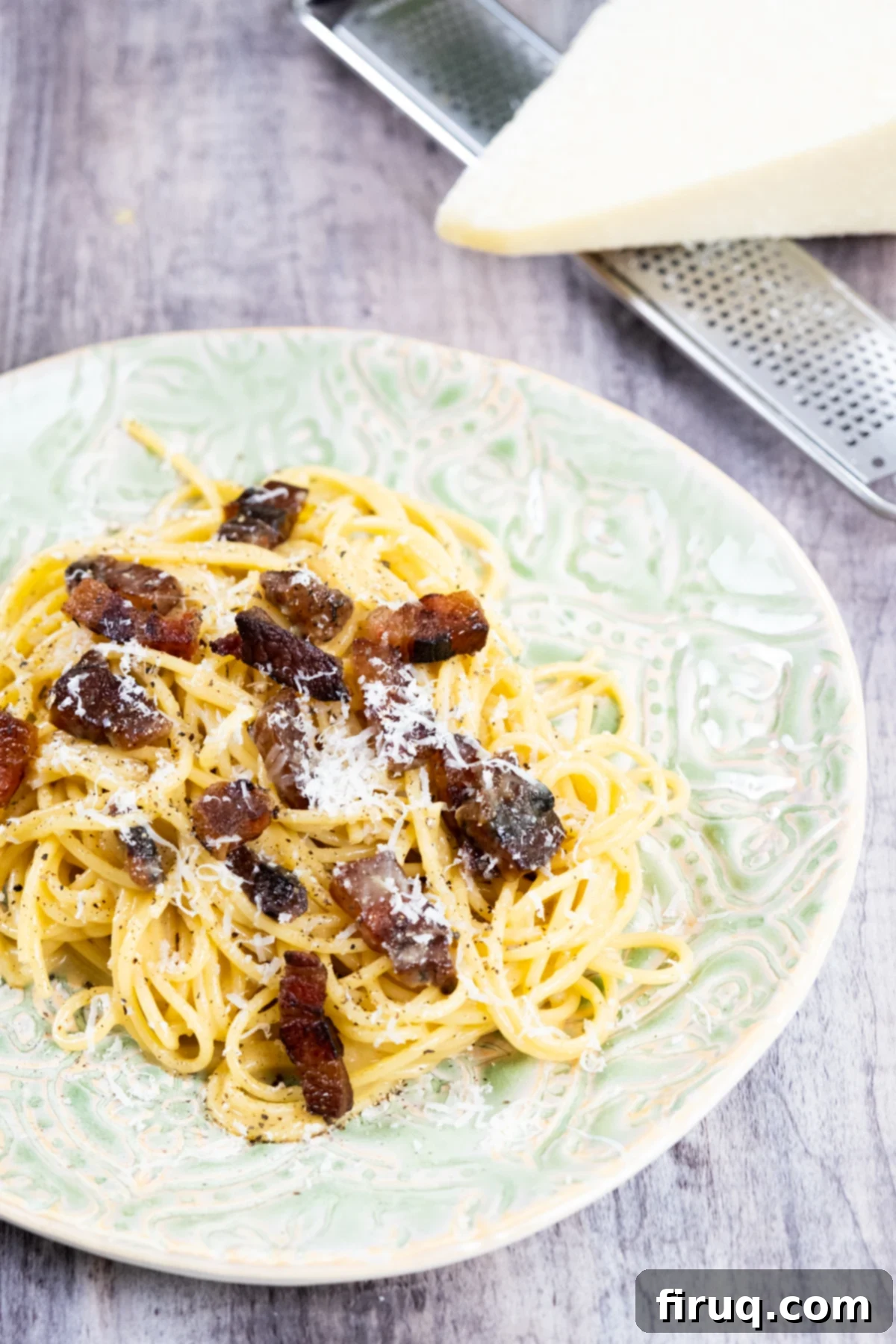
Essential Pro-Tips for Carbonara Mastery
-
Guanciale vs. Pancetta: Different Cooking Dynamics
It’s crucial to understand that guanciale and pancetta behave differently under heat. Guanciale, with its higher fat content and specific cure, is much more delicate than pancetta. I’ve found that guanciale is far more susceptible to burning if not constantly monitored. When rendering guanciale, maintain precise control over your saucepan’s heat, as it can brown and crisp up very quickly compared to pancetta. Remember to stir often to ensure even rendering and prevent scorching.
-
Pan Choice for Beginners: Embrace the Non-Stick
When you’re first learning the nuanced technique of making Carbonara, using a nonstick pan can be incredibly helpful. Nonstick pans don’t retain heat as aggressively as cast iron or stainless steel. This makes them more forgiving if your temperature control isn’t perfect, providing a safer buffer when you introduce the delicate egg mixture to prevent accidental scrambling.
-
The Cold Pan Start: A Golden Rule for Cured Meats
Always begin cooking cured meats like guanciale or pancetta in a cold pan. This method allows the fat to render slowly and gradually as the pan heats up. Slow rendering is key to achieving that perfect crispy texture while maximizing the release of the rich, flavorful fat that forms the foundation of your Carbonara sauce.
Guanciale vs. Pancetta in Carbonara: A Deeper Dive
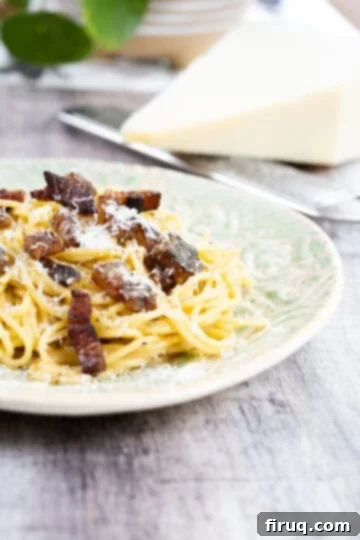
Carbonara with Guanciale: The Traditional Preference
When it comes to Carbonara with guanciale, you’re experiencing the dish in its most authentic form. Guanciale is inherently more tender and offers a distinctly richer, slightly sweeter, and more complex flavor compared to pancetta. Its fat renders into a silky, flavorful oil that is unparalleled for the Carbonara sauce. While guanciale is the undisputed preferred choice for this dish, sourcing it might require a trip to a specialty Italian deli or ordering it online.
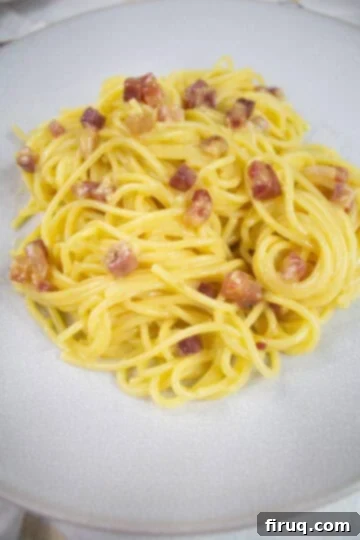
Carbonara with Pancetta: A Practical and Delicious Alternative
While guanciale is the ideal, Carbonara with pancetta is a perfectly delicious and often more accessible alternative. Pancetta, derived from pork belly, still provides that essential fatty oil to sauté the spaghetti in, contributing immense flavor. Its texture is typically slightly chewier and its flavor profile more savory than guanciale. I often make Carbonara with pancetta myself because it’s conveniently available at most supermarkets, whereas guanciale usually requires a special order. Don’t hesitate to use it if guanciale is out of reach – it’s still a fantastic dish!
Spaghetti Carbonara Do’s: Your Path to Authenticity
Adhering to these fundamental principles will ensure your Carbonara is nothing short of spectacular, achieving that sought-after authentic Roman taste and texture.
-
DO: Master the Art of Timing and Temperature.
Begin cooking your pancetta or guanciale as soon as you start boiling your pasta water. This synchronization is critical because everything needs to finish at roughly the same time. The pasta must be piping hot when it’s introduced to the pan. If the pasta cools down too much, the egg mixture won’t properly emulsify and adhere, leading to a broken or clumpy sauce.
-
DO: Consider a Nonstick Pan (Especially for Beginners).
If you’re new to making Carbonara, using a quality nonstick pan can be your best friend. Nonstick surfaces don’t retain heat as intensely as cast iron or stainless steel. This provides a greater margin for error, making it easier to manage the pan’s temperature and ensure the eggs gently cook into a creamy sauce rather than scrambling.
-
DO: Grate Your Pecorino Romano as Finely as Possible.
For the best results, grate your Pecorino Romano using the smallest holes on your grater. The finer the cheese, the more smoothly it will melt into the sauce. If the cheese is too thick or coarse, it’s highly likely to coagulate and become chunky rather than dissolving into a velvety emulsion.
-
DO: Use a Combination of Whole Eggs and Egg Yolks.
To achieve the perfect balance of richness and body, aim for a ratio that includes both whole eggs and extra egg yolks (e.g., 2 whole eggs + 2 egg yolks per 1 lb of pasta). The yolks contribute immense richness and color, while the whites, when properly managed, help thicken the sauce due to their protein content binding with the starchy pasta water. This combination creates a beautifully creamy sauce.
-
DO: Remove the Pan from Heat When Adding the Egg Mixture.
This is perhaps the most critical “do.” Before introducing the egg and Pecorino mixture to the pasta, remove the pan completely from the heat for a moment or two. Allow the pan to cool slightly. This momentary cooling prevents the eggs from shocking and scrambling upon contact with excessive heat. The residual warmth from the pasta and the pan will be sufficient to gently cook the eggs into a smooth emulsion as you stir vigorously.
Spaghetti Carbonara Don’ts: Mistakes to Avoid
To truly respect the tradition and achieve culinary excellence, avoid these common pitfalls that often lead to disappointment.
-
DON’T: Use Pre-Grated or Imitation Cheese.
Never use fake parmesan or pre-grated Pecorino Romano cheese. These often contain anti-caking agents that hinder proper melting and can give a grainy texture. Invest in a block of authentic Pecorino Romano and grate it yourself just before use. Also, allow the grated cheese to come to room temperature; cold cheese is more prone to clumping.
-
DON’T: Rinse, Cool, Break, or Forget to Salt Your Pasta.
These are fundamental pasta rules! Don’t rinse your pasta, as this washes away the crucial starch needed for sauce emulsification. Don’t let your pasta cool; it needs to be hot for the eggs to cook gently. Don’t break your spaghetti; true Italian pasta is served long. And absolutely, don’t forget to generously salt the water! Pasta water should be salty like the sea, as this is your only chance to season the pasta itself.
-
DON’T: Use a Stainless Steel Pan (If It’s Your First Time).
While experienced chefs might use stainless steel, its high heat retention can be unforgiving for Carbonara novices. For your initial attempts, stick with a nonstick pan to give yourself more control over the temperature, as explained in the “Do’s” section.
-
DON’T: Add Cream, Milk, or Butter.
This is a cardinal sin in authentic Carbonara. Cream, milk, or butter are simply not needed and fundamentally alter the dish’s character. If your Carbonara is made correctly, the emulsion of egg, cheese, rendered pork fat, and starchy pasta water will create a luxuriously creamy sauce without any added dairy products.
-
DON’T: Substitute Bacon for Pancetta or Guanciale.
While bacon is delicious, its smoky flavor is too dominant and will completely change the delicate profile of traditional Carbonara. Guanciale or pancetta provides a rich, savory, and un-smoked pork flavor that is essential to the dish’s identity. Stick to these traditional cured meats for an authentic experience.
-
DON’T: Let the Egg Mixture Sit Still in the Pot with the Pasta.
Once you add the egg and cheese mixture to the hot pasta (after removing the pan from the direct heat), you must keep it moving! Stir vigorously and continuously until the sauce thickens and emulsifies. Allowing it to sit, even for a moment, can lead to localized cooking and that dreaded scrambled egg texture.
Carbonara Perfection: Silky Smooth Sauce vs. Pilling Catastrophe
The texture of your Carbonara sauce is the ultimate indicator of success. Understanding the difference between a perfectly emulsified, silky sauce and a disappointing, “pilled” one is paramount.
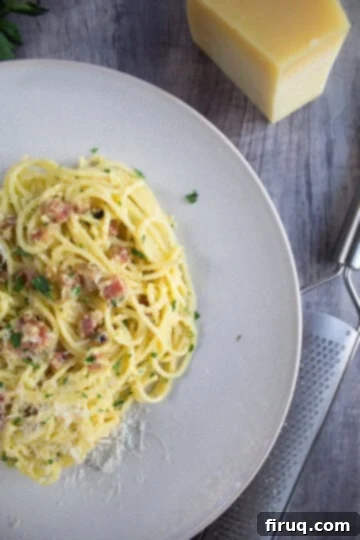
Understanding “Pilling”: The Scrambled Egg Pitfall
The image on the left illustrates “pilling,” a common Carbonara mistake. This is exactly what we want to avoid! Instead of a smooth sauce, the egg and cheese mixture has coagulated into small, cooked lumps, resembling scrambled eggs. This happens when the pan or pasta is too hot when the egg mixture is added, or if the mixture isn’t stirred vigorously enough, causing the eggs to seize and cook unevenly.
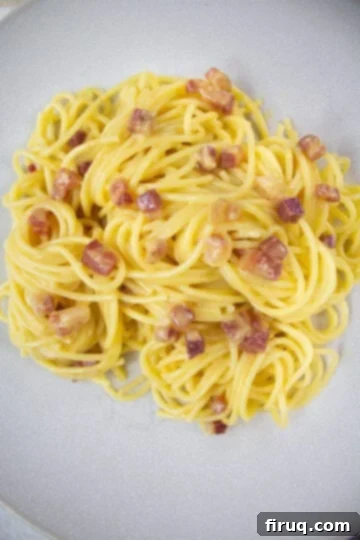
Achieving Silky Smoothness: The Emulsion Masterpiece
This sauce, as seen in the image on the right, boasts the smooth, silky texture that is the hallmark of perfectly executed Carbonara. This luxurious consistency is achieved through a delicate emulsion of the rendered pork fat, the egg and cheese mixture, and the starchy pasta water. It requires precise temperature control and continuous, vigorous stirring to gently cook the eggs and melt the cheese into a cohesive, unctuous coating for every strand of pasta.
Common Carbonara Mistakes & How to Fix Them
Even with the best intentions, small errors can occur. Here’s a look at a couple more common Carbonara mistakes and how to prevent or remedy them.
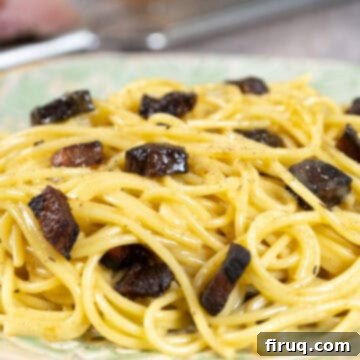
Burnt Guanciale: Tender vs. Over-Crisp
The image here shows guanciale that was left on the heat for slightly too long, resulting in a darker, almost burnt appearance. While still edible and contributing flavor, authentic Carbonara often benefits from guanciale that is tender on the inside with just a crisp exterior. To avoid this, ensure you render the guanciale over medium-low heat, stirring frequently. If it starts to brown too quickly, lower the heat or remove it from the pan sooner than later.
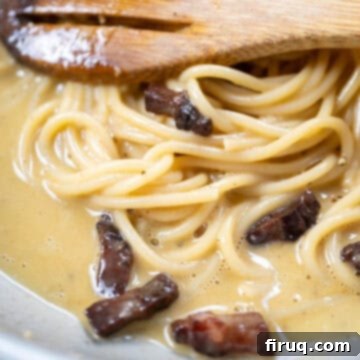
Excessive Pasta Water: Troubleshooting a Thin Sauce
Here, I’ve clearly added too much pasta water, resulting in a sauce that is overly thin and runny. The good news is, this mistake is often salvageable! If your sauce is too liquidy, continue stirring it vigorously off the heat. The gentle evaporation and continued emulsion can help thicken it. You can also carefully add a little more finely grated Pecorino Romano, stirring constantly, to help absorb some of the excess liquid and thicken the sauce. Always add pasta water gradually, a tablespoon at a time, until you reach your desired consistency.
Spaghetti Carbonara FAQs
Guanciale is made from cured pork jowl and is highly prized for its exceptionally rich flavor, distinct tenderness, and superior fat rendering. It has a unique, slightly sweet and peppery profile. Pancetta, on the other hand, is made from cured pork belly. It is generally firmer in texture and offers a saltier, more savory taste. While guanciale is traditional for Carbonara, pancetta is a widely accepted and delicious substitute, especially when guanciale is harder to find.
The primary difference lies in their origin and milk source. Pecorino Romano is a hard, salty cheese made from sheep’s milk, giving it a sharper, tangier, and more pungent flavor profile. It’s also typically firmer and whiter. Parmigiano-Reggiano is made from cow’s milk and is aged for a longer period, resulting in a sweeter, nuttier, and more complex flavor with a slightly grainy texture. For authentic Carbonara, Pecorino Romano is the traditional choice due to its distinctive sharp flavor, though a small amount of Parmigiano can occasionally be added for depth.
For an authentic Roman Carbonara, absolutely avoid adding garlic, cream, milk, or butter. These ingredients are not part of the traditional recipe and will fundamentally change the dish’s character. The classic creamy texture is achieved through the emulsion of egg, Pecorino, rendered guanciale fat, and starchy pasta water – no added dairy is needed. Similarly, while delicious, bacon is not a suitable substitute for guanciale or pancetta due to its smoky flavor.
Preventing scrambled eggs is key to a silky Carbonara. The most important technique is to remove the pan from direct heat and allow it to cool slightly (for a minute or two) before adding the egg and cheese mixture. The residual heat from the pasta and the pan will be sufficient to gently cook the eggs and melt the cheese. Crucially, stir vigorously and continuously the moment the egg mixture enters the pan. This constant movement helps create a smooth emulsion and prevents the eggs from cooking into lumps.
It is strongly advised against using pre-grated, store-bought cheese for Carbonara. These products often contain anti-caking agents like cellulose, which can prevent the cheese from melting smoothly and result in a grainy or clumpy sauce. For the best, silkiest results, always grate a block of fresh Pecorino Romano yourself just before preparing the dish.
More Classic Italian Pasta Dishes to Explore
- Lemon Pasta with Spinach
- Linguine with Red Clam Sauce
- Shrimp Scampi Without Wine
- Classic Linguine Alla Puttanesca
Please leave a comment and star rating below in the recipe card! We love to hear what you think of our recipes and your culinary adventures. Feel free to tag us on Instagram @vindelgiudice.
📖 Recipe
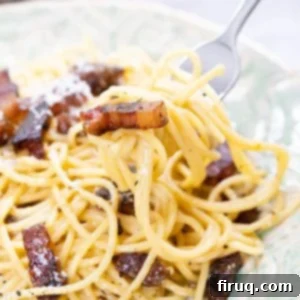
Authentic Spaghetti Carbonara (Do’s and Don’ts Guide)
Vincent DelGiudice
Pin Recipe
15 minutes
15 minutes
30 minutes
Main Course
Italian, Roman
5
servings
705
kcal
Equipment
-
1 large nonstick saucepan or skillet -
1 Medium mixing bowl -
Whisk
Ingredients
-
1
lb
dried spaghetti or bucatini -
1
cup
Pecorino Romano, freshly grated (finely) -
2
large eggs -
2
additional egg yolks -
6
oz
guanciale (or pancetta), diced into ½-inch cubes -
½-¾
cup
pasta water, reserved from cooking -
1-2
tsp
freshly ground black pepper (coarse) -
Salt for pasta water
Instructions
-
1. Cook Pasta: Bring a large pot of water to a rolling boil. Season generously with salt (it should taste like the sea). Add spaghetti and cook according to package directions until perfectly al dente. Reserve ½ to ¾ cup of the starchy pasta water before draining.
-
2. Render Guanciale (or Pancetta): While the pasta boils, place the diced guanciale (or pancetta) into a cold nonstick pan. Turn the heat to medium and slowly render the fat for 8-10 minutes, stirring occasionally, until it’s golden brown and slightly crispy. Remove the crispy guanciale with a slotted spoon and set aside, leaving all the rendered fat in the pan.
-
3. Prepare Egg & Cheese Mixture: In a medium mixing bowl, combine the 2 whole eggs, 2 egg yolks, and 1 cup of finely grated Pecorino Romano. Whisk vigorously until the mixture is smooth and well combined. Ensure no lumps of cheese remain.
-
4. Build Sauce Base: Add ¼ cup of the reserved pasta water to the rendered guanciale fat in the saucepan. Stir well to combine and create a slightly emulsified base.
-
5. Combine Pasta: Immediately add the hot, drained spaghetti to the saucepan with the fat and pasta water mixture. While still in the pan (but with the heat OFF), sprinkle with 1 teaspoon of freshly ground black pepper. Toss and stir vigorously to coat the pasta evenly.
-
6. Create Creamy Sauce (Crucial Step): Remove the pan completely from the burner and let it cool for 1-2 minutes. This is vital to prevent the eggs from scrambling. Add the egg and Pecorino mixture to the pasta. Begin stirring vigorously and continuously, scraping the bottom of the pan. As you stir, the sauce will initially be thin, but it will gradually thicken into a smooth, creamy emulsion. If the sauce becomes too thick, add more reserved pasta water (1 tablespoon at a time) while continuing to stir. Add remaining black pepper to taste.
-
7. Serve Immediately: Return the crispy guanciale to the pan and toss once more. Transfer the Carbonara immediately to warm serving bowls to prevent the eggs from overcooking. Serve with an extra sprinkle of freshly grated Pecorino Romano and black pepper if desired. Enjoy without delay!
Notes
- Cold Pan for Cured Meats: Always start cooking meat like guanciale or pancetta from a cold pan. This allows the fat to render slowly, resulting in maximum flavor and a perfectly crispy texture.
- Beginner’s Pan Choice: If you’re new to making Carbonara, using a nonstick pan can be beneficial. Nonstick pans don’t retain heat as much, offering more forgiveness and control when adding the temperature-sensitive egg mixture.
- Finely Grate Cheese: Ensure your Pecorino Romano is grated as finely as possible. Coarsely grated cheese is more likely to clump and create a lumpy sauce rather than a smooth emulsion.
- Salt Your Pasta Water: The pasta water should be well-salted (like the sea) to season the pasta itself, which is crucial for the overall flavor of the dish.
Nutrition
Calories:
705
kcal
Carbohydrates:
69
g
Protein:
25
g
Fat:
36
g
Saturated Fat:
15
g
Polyunsaturated Fat:
1
g
Monounsaturated Fat:
3
g
Trans Fat:
0.01
g
Cholesterol:
200
mg
Sodium:
1031
mg
Potassium:
252
mg
Fiber:
3
g
Sugar:
3
g
Vitamin A:
282
IU
Calcium:
252
mg
Iron:
2
mg
Tried this recipe?
We’d love for you to Leave a Review!
